Ware C. Information Visualization: Perception for Design
Подождите немного. Документ загружается.

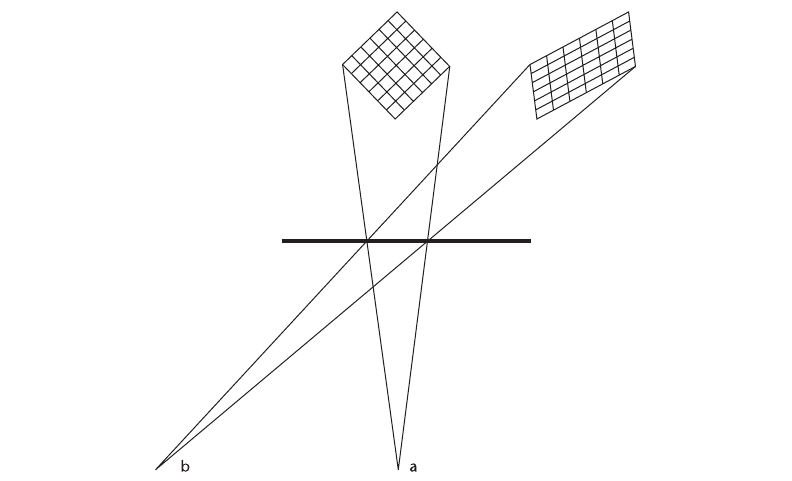
computed and viewed so that the perspective is “correct” at all times by adjusting the viewpoint
parameters in the computer graphics software (Deering, 1992; Ware et al., 1993). There are two
reasons why this might be desirable, despite the fact that incorrect perspective viewing of a picture
seems generally unimportant. The first reason is that as an observer changes position, the per-
spective image will change accordingly, resulting in motion parallax. Motion parallax is itself a
depth cue, as discussed later in the structure-from-motion section. The second reason is that in
some virtual-reality systems, it is possible to place the subject’s hand in the same space as the
virtual computer graphics imagery. When we make visually guided hand movements toward some
object in the world, we are constantly correcting our movements based on visual feedback. If
this were done using computer graphics imagery to represent a virtual object and a virtual image
of the subject’s hand, head-coupled perspective could be necessary to keep the subject’s body
sense (kinesthetic feedback) of hand position aligned with his or her visual feedback. An example
of an experimental setup is shown in Figure 8.6. However, research has shown that as long as
continuous visual feedback is provided, without excessive lag, people can adjust rapidly to simple
changes in the eye–hand relationship (Held et al., 1966). The effects of lag on performance are
discussed further in Chapter 10.
264 INFORMATION VISUALIZATION: PERCEPTION FOR DESIGN
Figure 8.5 When a perspective picture is seen from the wrong viewpoint (point b), simple geometry predicts that
large distortions should be seen. However, they are generally not seen or, when seen, are minimal.
ARE8 1/20/04 5:05 PM Page 264
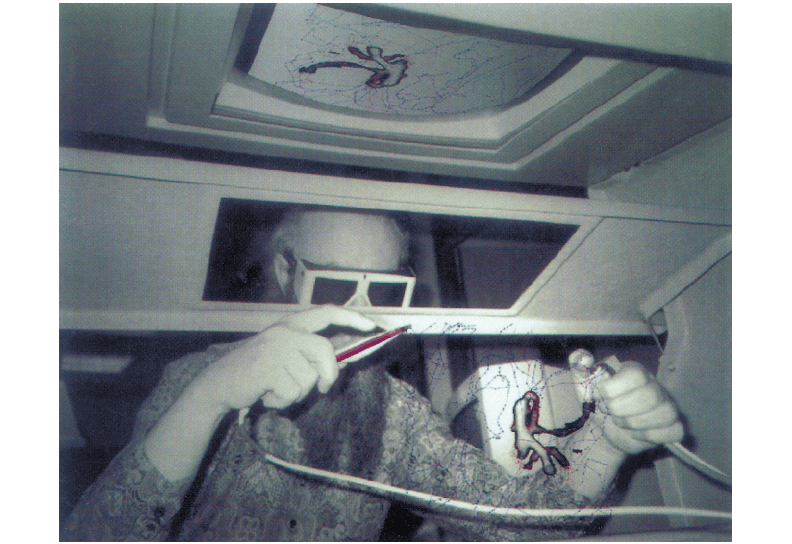
When virtual-reality head-mounted displays are used, it is essential that the perspective be
coupled to a user’s head movement, because the whole point is to allow users to change view-
point in a natural way. Experimental evidence supports the idea that head-coupled perspective
enhances the sense of presence in virtual spaces more than stereoscopic viewing (Arthur et al.,
1993; Pausch et al., 1996).
Occlusion
If one object overlaps or occludes another, it appears closer to the observer. See Figure 8.7. This is
probably the strongest depth cue, but it provides only binary information. An object is either
behind or in front of another; no information is given about the distance between them. A kind of
partial occlusion occurs when one object is transparent or translucent. In this case, there is a color
difference between the parts of an object that lie behind the transparent plane and the parts that
are in front of it. This can be useful in positioning one object inside another (Zhai et al., 1994).
Space Perception and the Display of Data in Space 265
Figure 8.6 A user is attempting to trace 3D blood vessels in an interface that puts his hand in the same space as the
virtual computer graphics imagery. From Serra et al., 1997.
ARE8 1/20/04 5:05 PM Page 265

266 INFORMATION VISUALIZATION: PERCEPTION FOR DESIGN
Figure 8.7 An object that occludes another appears closer to the viewer.
Occlusion can be useful in design; for example, the tabbed cards illustrated in Figure 8.8(a)
use occlusion to provide rank-order information, in addition to rapid access to individual cards.
Although modern graphical user interfaces (GUIs) are usually described as being 2D, they are
actually 3D in a nontrivial way. Overlapping windows rely on our understanding of occlusion
to be effective. See Figure 8.8(b).
Depth of Focus
When we look around, our eyes change focus to bring the images of fixated objects into sharp
focus on the fovea. As a result, the images of both nearby and more distant objects become
blurred. The equations that determine depth of focus are presented in Chapter 2. Focus effects
are important in separating foreground objects from background objects, as shown in Figure 8.9.
Perhaps because of its role as a depth cue, simulating depth of focus is an excellent way to high-
light information by blurring everything except that which is critical. Unfortunately, the tech-
nique is computationally expensive and thus currently limited in utility.
Focus can be considered a pictorial depth cue only if the object of fixation can be predicted.
In normal vision, our attention shifts and our eyes refocus dynamically depending on the dis-
tance of the object fixated. Chapter 2 describes a system designed to change focus information
based on measured point of fixation in a virtual environment.
Cast Shadows
Cast shadows are a very potent cue to the height of an object above a plane, as illustrated in
Figure 8.10(a). They can function as a kind of indirect depth cue—the shadow locates the object
with respect to some surface in the environment. In the case of Figure 8.10, this surface is not
present in the illustration but is assumed by the brain. In a multifactor experiment, Wanger
et al. (1992) found that shadows provided the strongest “depth” cue when compared to tex-
ture, projection type, frames of reference, and motion. But it should be noted that they used a
checkerboard as a base plane to provide the actual distance information. Cast shadows function
ARE8 1/20/04 5:05 PM Page 266
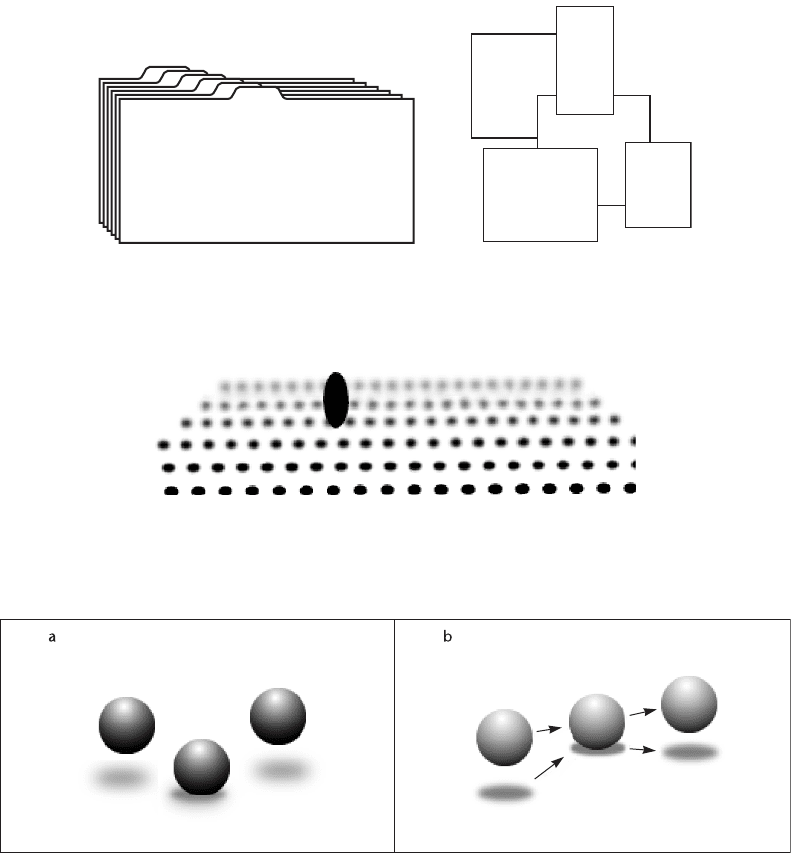
Space Perception and the Display of Data in Space 267
a
b
c
d
e
f
a
b
Figure 8.8 (a) Careful use of occlusion enables small tabs to provide access to larger objects. (b) Window interfaces
use occlusion.
Figure 8.9 The eye adjusts to bring objects of interest into sharp focus. As a result, objects at different distances
become blurred.
Figure 8.10 (a) Shadows can provide a strong cue for the relative height of objects above a plane. (b) The effect
becomes even stronger with motion. The ball actually appears to bounce when the ball and shadow are
animated to follow the trajectories shown.
ARE8 1/20/04 5:05 PM Page 267

best as a height-above-surface cue when there is a relatively small distance between the object
and the surface, and they can be especially effective in showing when an object is very close to
the point of contact (Madison et al., 2001).
Cast shadows are useful in distinguishing information that is layered a small distance above
a planar surface, as illustrated in Figure 8.11. This technique can be applied to layered map dis-
plays of the type used in geographical information systems (GISs). In complex environments,
where objects are arranged throughout 3D space, cast shadows can be confusing rather than
helpful, because it may not be possible to determine perceptually which object cast a particular
shadow.
Kersten et al. (1997) showed that cast shadows are especially powerful when objects are in
motion. One of their demonstrations is illustrated in Figure 8.10(b). In this case, the apparent
trajectory of a ball moving in 3D space is caused to change dramatically depending on the path
of the object’s shadow. The image of the ball actually travels in a straight line, but the ball appears
to bounce because of the way the shadow moves. In this study, shadow motion was shown to
be a stronger depth cue than change in size with perspective.
It seems likely that shadows can be correctly interpreted without being realistic. Kersten
et al. (1996) found no effect of shadow quality in their results. However, one of the principal
cues in distinguishing shadows from nonshadows in the environment is the lack of sharpness in
shadow edges. Fuzzy shadows are likely to lead to less confusing images.
Shape-from-Shading
See Chapter 7 for a discussion of the perception of surface shape-from-shading information. We
can add one more point here. Shading information can be useful in emphasizing the affordances
of display widgets such as buttons and sliders, even in displays that are very flat. Figure 8.12
illustrates a slider enhanced with shading. This technique is widely used in today’s GUIs.
268 INFORMATION VISUALIZATION: PERCEPTION FOR DESIGN
Figure 8.11 Cast shadows can be useful in making data appear to stand out above an opaque plane.
ARE8 1/20/04 5:05 PM Page 268

Eye Accommodation
The eye changes focus to bring attended objects into sharp focus on the retina. However, because
we are only capable of focusing to one-half of a diopter, this means that accommodation can
provide limited information about the distance to nearby objects (Hochberg, 1971). Accommo-
dation does not appear to be used to judge distance directly, but it is used in computing the size
of nearby objects (Wallach and Floor, 1971).
Structure-from-Motion
When an object is in motion or when we ourselves move through the environment, the result is
a dynamically changing pattern of light on the retina. Structure-from-motion information is gen-
erally divided into two different classes: motion parallax and the kinetic depth effect.
An example of motion parallax occurs when we look sideways out of a car or train window.
Things nearby appear to be moving very rapidly, whereas objects close to the horizon only
appear to move gradually. Overall, there is a velocity gradient, as illustrated in Figure 8.13(a).
When we move forward through a cluttered environment, the result is a very different expand-
ing pattern of motion, like that shown in Figure 8.13(b). Wann et al. (1995) showed that sub-
jects were able to control their headings with an accuracy of 1 to 2 degrees when they were given
feedback from a wide-screen field of dots through which they had to steer. There is also evidence
for specialized neural mechanisms sensitive to the time to contact with visual moving targets.
These may enable animals to become aware of objects on a collision course (Wang and Frost,
1992).
The kinetic depth effect can be demonstrated with a wire bent into a complex 3D shape and
projected onto a screen, as shown in Figure 8.13(c). Casting the shadow of the wire will suffice
for the projection. The result is a two-dimensional line, but if the wire is rotated, the three-dimen-
sional shape of the wire immediately becomes apparent (Wallach and O’Connell, 1953). The
kinetic depth effect dramatically illustrates a key concept in understanding space perception. The
brain generally assumes that objects are rigid in 3D space, and the mechanisms of object per-
ception incorporate this constraint. The moving shadow of the rotating bent wire is perceived as
a rigid 3D object, not as a wiggling 2D line. It is easy to simulate this in a computer graphics
system by creating an irregular line, rotating it about a vertical axis, and displaying it using stan-
dard graphics techniques.
Space Perception and the Display of Data in Space 269
Figure 8.12 Even with mostly 2D interfaces, subtle shading can make sliders and other widgets look like objects that
can be manipulated.
ARE8 1/20/04 5:05 PM Page 269
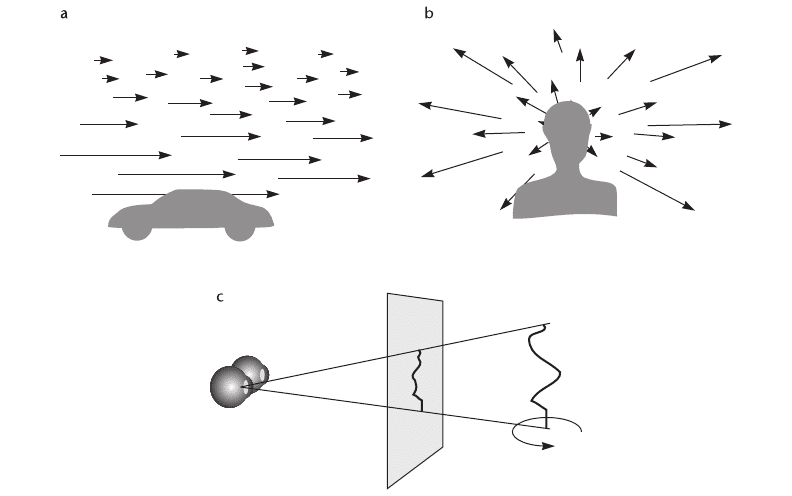
For many tasks, structure-from-motion information is at least as important as stereoscopic
depth in providing us with information about the spatial layout of objects in space (Rogers and
Graham, 1979). It helps us determine both the 3D shapes of objects and the large-scale layout
of objects in space. Structure-from-motion is the reason for the effectiveness of fly-through
animated movies that take an observer through a data space.
Eye Convergence
When we fixate an object with both eyes, they must converge to a degree dictated by the dis-
tance of the object. This vergence angle is illustrated in Figure 8.14. Given the two line-of-sight
vectors, it is a matter of simple trigonometry to determine the distance to the fixated object.
However, the evidence suggests that the human brain is not good at this geometric computation
except for objects within arm’s length (Viguier et al., 2001). The vergence sensing system appears
capable of quite rapid recalibration in the presence of other spatial information (Fisher and
Cuiffreda, 1990).
270 INFORMATION VISUALIZATION: PERCEPTION FOR DESIGN
Figure 8.13 Three different kinds of structure-from-motion information. (a) The velocity gradient that results when the
viewer is looking sideways out of a moving vehicle. (b) The velocity field that results when the viewer is
moving forward through the environment. (c) The kinetic depth information that results when a rotating
rigid object is projected onto a screen.
ARE8 1/20/04 5:05 PM Page 270

Stereoscopic Depth
There is an often-expressed opinion that stereoscopic displays allow “truly” three-dimensional
images. In advertising literature, potential buyers are urged to buy stereoscopic display equip-
ment and “see it in 3D.” As should be plain from this chapter, stereoscopic disparity is only one
of many depth cues that the brain uses to analyze 3D space, and it is by no means the most useful
one. If fact, as much as 20% of the population may be stereo-blind, yet they function perfectly
well and in fact are often unaware that they have a disability. Nevertheless, stereoscopic displays
can provide a particularly compelling sense of a three-dimensional virtual space, and for certain
tasks they can be extremely useful.
The basis of stereoscopic depth perception is forward-facing eyes with overlapping visual
fields. On average, human eyes are separated by about 6.4 centimeters; this means that the
brain receives slightly different images, which can be used to compute relative distances of pairs of
objects. Stereoscopic depth is a technical subject, and we therefore begin by defining some of the
terms.
Figure 8.15 illustrates a simple stereo display. Both eyes are fixated on the vertical line (a
for the right eye, c for the left eye). A second line d in the left eye’s image is fused with b in the
right eye’s image. The brain resolves the discrepancy in line spacing by perceiving the lines as
being at different depths, as shown.
Angular disparity is the difference between the angular separation of a pair of points imaged
by the two eyes (disparity = a - b). Screen disparity is the distance between parts of an image
on the screen (screen disparity = (c - d) - (a - b)).
If the disparity between the two images becomes too great, double vision, called diplopia,
occurs. Diplopia is the appearance of the doubling of part of a stereo image when the visual
system fails to fuse the images. The 3D area within which objects can be fused and seen without
double images is called Panum’s fusional area. In the worst case, Panum’s fusional area has
remarkably little depth. At the fovea, the maximum disparity before fusion breaks down is only
Space Perception and the Display of Data in Space 271
Figure 8.14 The vergence angle q varies as the eyes fixate on near and far objects.
ARE8 1/20/04 5:05 PM Page 271
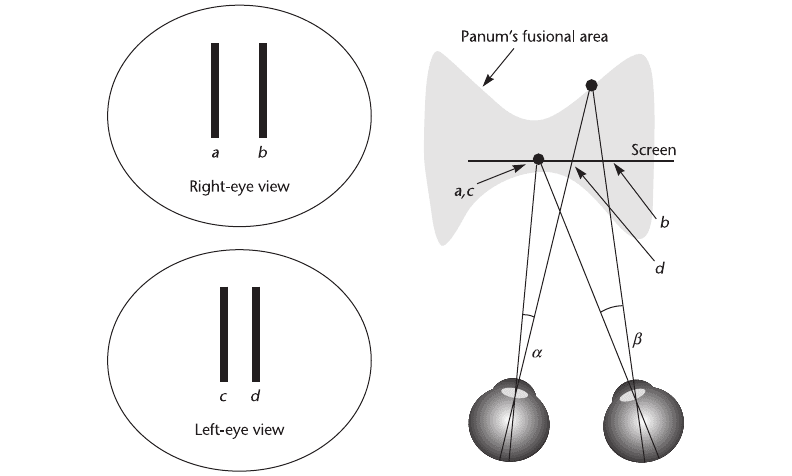
1/10 degree, whereas at 6 degrees eccentricity (of the retinal image from the fovea), the limit is
1/3 degree (Patterson and Martin, 1992).
It is worthwhile to consider what these numbers imply for monitor-based stereo displays. A
screen with 30 pixels/cm, viewed at 57cm, will have 30 pixels per degree of visual angle. The
1/10-degree limit on the visual angle before diplopia occurs translates into about three pixels of
screen disparity. This means that we can only display three whole-pixel-depth steps before
diplopia occurs, either in front of or behind the screen. It also means that in the worst case, it
will only be possible to view a virtual image that extends in depth a fraction of a centimeter from
the screen (assuming an object on the screen is fixated). However, it is important to emphasize
that this is a worst-case scenario. It is likely that antialiased images will allow better-than-pixel
resolution, for exactly the same reason that vernier acuities can be achieved to better-than-pixel
resolution (discussed in Chapter 2). In addition, the size of Panum’s fusional area is highly depen-
dent on a number of visual display parameters, such as the exposure duration of the images and
the size of the targets. Both moving targets and blurred images can be fused at greater dispari-
272 INFORMATION VISUALIZATION: PERCEPTION FOR DESIGN
Figure 8.15 A simple stereo display. Different images for the two eyes are shown on the left. On the right, a top-down
view shows how the brain interprets this display. The vertical lines a and b in the right-eye image are
perceptually fused with c and d, respectively, in the left-eye image.
ARE8 1/20/04 5:05 PM Page 272
ties, and the fusional area becomes larger, with lateral separation of the image components
(Patterson and Martin, 1992). Depth judgments can also be made outside the fusional area,
although these are less accurate.
Stereopsis is a superacuity. We can resolve disparities of only 10 seconds of arc at better than
chance. This means that we should be able to see a depth difference between an object at 1 kilo-
meter and an object at infinity, under optimal viewing conditions.
Problems with Stereoscopic Displays
It is common for users of 3D visualization systems with stereoscopic display capabilities to disable
stereo viewing once the novelty has worn off, and view the data using a monocular perspective.
There are a number of reasons that stereoscopic displays are disliked. Double-imaging problems
tend to be much worse in stereoscopic computer displays than in normal viewing of the 3D envi-
ronment. One of the principal reasons for this is that in the real world, objects farther away than
the one fixated are out of focus on the retina. Because we can fuse blurred images more easily
than sharply focused images, this reduces diplopia problems in the real world. In addition, focus
is linked to attention and foveal fixation. In the real world, double images of nonattended periph-
eral objects generally will not be noticed. Unfortunately, in present-day computer graphics
systems, particularly those that allow for real-time interaction, depth of focus is never simulated.
All parts of the computer graphics image are therefore equally in focus, even though some parts
of the image may have large disparities. Thus, the double images that occur in stereoscopic com-
puter graphics displays are very obtrusive.
Frame Cancellation
Valyus (1966) coined the phrase frame cancellation to describe a common problem with
stereoscopic displays. If the stereoscopic depth cues are such that a virtual image should
appear in front of the screen, the edge of the screen appears to occlude the virtual object,
as shown in Figure 8.16. Occlusion overrides the stereo depth information, and the depth effect
collapses. This is typically accompanied by a double image of the object that should appear in
front.
The Vergence–Focus Problem
When we change our fixation between objects placed at different distances, two things happen:
the convergence of the eyes changes (vergence), and the focal lengths of the lenses in the eyes
accommodate to bring the new object into focus. The vergence and the focus mechanisms are
coupled in the human visual system. If one eye is covered, the vergence and the focus of the
covered eye change as the uncovered eye accommodates objects at different distances. This illus-
trates vergence being driven by focus. The converse also occurs: a change in vergence can drive
a change in focus.
Space Perception and the Display of Data in Space 273
ARE8 1/20/04 5:05 PM Page 273
